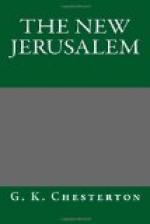Now I myself, I cheerfully admit, feel that enormity in Kensington Gardens as something quite natural. I feel it so because I have been brought up, so to speak, under its shadow; and stared at the graven images of Raphael and Shakespeare almost before I knew their names; and long before I saw anything funny in their figures being carved, on a smaller scale, under the feet of Prince Albert. I even took a certain childish pleasure in the gilding of the canopy and spire, as if in the golden palace of what was, to Peter Pan and all children, something of a fairy garden. So do the Christians of Jerusalem take pleasure, and possibly a childish pleasure, in the gilding of a better palace, besides a nobler garden, ornamented with a somewhat worthier aim. But the point is that the people of Kensington, whatever they might think about the Holy Sepulchre, do not think anything at all about the Albert Memorial. They are quite unconscious of how strange a thing it is; and that simply because they are used to it. The religious groups in Jerusalem are also accustomed to their coloured background; and they are surely none the worse if they still feel rather more of the meaning of the colours. It may be said that they retain their childish illusion about their Albert Memorial. I confess I cannot manage to regard Palestine as a place where a special curse was laid on those who can become like little children. And I never could understand why such critics who agree that the kingdom of heaven is for children, should forbid it to be the only sort of kingdom that children would really like; a kingdom with real crowns of gold or even of tinsel. But that is another question, which I shall discuss in another place; the point is for the moment that such people would be quite as much surprised at the place of tinsel in our lives as we are at its place in theirs. If we are critical of the petty things they do to glorify great things, they would find quite as much to criticise (as in Kensington Gardens) in the great things we do to glorify petty things. And if we wonder at the way in which they seem to gild the lily, they would wonder quite as much at the way we gild the weed.
There are countless other examples of course of this principle of self-criticism, as the necessary condition of all criticism. It applies quite as much, for instance, to the other great complaint which my Kensington friend would make after the complaint about paltry ornament; the complaint about what is commonly called backsheesh. Here again there is really something to complain of; though much of the fault is not due to Jerusalem, but rather to London and New York. The worst superstition of Jerusalem, like the worst profligacy of Paris, is a thing so much invented for Anglo-Saxons that it might be called an Anglo-Saxon institution. But here again the critic could only really judge fairly if he realised with what abuses at home he ought really to compare this particular




